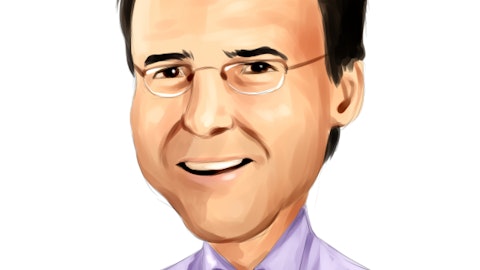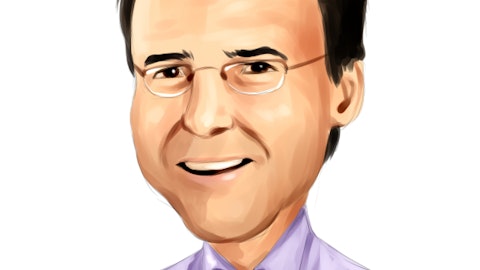Steven Fisher: Thanks. Good morning. So just, I’m curious how the fleet productivity you reported in Q4? How did that compare to what you thought you could do going in some of the investors we chat with kind of seem to note the moderation in fleet productivity as the year progressed. I guess, what’s the message you want to give to them about how they should think about sort of lower level of fleet productivity in 2023? Is it just more that it’s settling into a more normalized level, still above your hurdle rate, but just kind of moving beyond these unusual dynamics of utilization and inflation in 2021 and 2022 and it’s just sort of steadily into a more normalized path. Is that what message you would give? Or how would you frame that?
Matt Flannery: I think that’s €“ first of all, this is an output, right? So, we’re going to manage the heck out of rate and time even though we don’t report it out individually. And I’m very pleased that the whole industry is doing that, and we see the discipline shown in the industry from that perspective. But I think the way you characterize it is fair, we were pleased with our Q4 fleet productivity. It was what we expected. And just for clarity for those that may not have picked it up, the 5.9% as reported when you take out Ahern, that would be 6.5%. So that’s about three weeks of Ahern built into the fourth quarter. So, we will report next year fleet productivity on as reported and on a pro forma basis, so you could see that impact.
And what we’ll really be focused on is making sure we take the entirety of the fleet and drive more value out of it. And any time this number exceeds our threshold we expect to comfortably do next year will €“ that’s a net gain. And we’ll be measuring that on a pro forma basis for you see what we’re doing with the Ahern fleet against their baseline as well.
Steven Fisher: Okay. And then I’m wondering about the general cadence of project activity that you expect during the year and where you are with these large projects. Obviously, you talked about taking all the extra CapEx more front-end loaded. I guess I’m wondering how you compare what’s in the €“ still in the planning stages on these large projects compared to what you have on rent at the moment because there are some investors that, I think your business is slowing down, but I’m wondering if there’s actually €“ if you’re seeing more large projects in the planning stages than what’s on rent, I’m wondering if that could actually lead to some type of acceleration as the next year or two plays out?
Matt Flannery: Yes. We’ll stay away from quarterly cadence, but obviously, it gets held by our pulp that we expect to need more fleet come the spring build up. We’re not €“ Q1 is always going to be the slowest quarter seasonally, but we see strong demand here today, and we expect that to continue to ramp up from big projects. And then once you really get to the peak season, once you get past May, June and even all the local market stuff starts popping. So when you hear about this pull forward, we don’t feel the fleet that we would normally have had ready is going to be enough when we get to the real build season in April. And that’s really more what that pretends to be in Q1, isn’t really the focus, the focus in is, are we going to be ready for the build, all these projects that are scratching dirt or coming out of the ground that we’re going to need, we’re going to need to mobilize fleet for in the spring.
Steven Fisher: Okay. Just a quick clarification, if I could. What’s the embedded flow-through that you have on the Ahern business in 2023? And compared to 2022, you got a 55% pro forma for legacy or? What’s the Ahern flow through?
Matt Flannery: Yes. Steve, that one is harder to speak to just because of the way we integrate acquisitions, especially in gen rent, and that’s why it’s easier to frame as a function of pro forma. So I think you hit the nail on the head, certainly as reported, flow-through would look like 48 €“ or excuse me, as reported looks like 48% pro forma 55%, but it’s hard to kind of discretely break apart the businesses. The one thing I would note, just to remind people of, we do think we’ll achieve about $30 million of the cost savings out of the $40 million we talked about. So we can certainly share that. Yes, in 2023, we’ll hold $40 million, but we only get about $30 million of it in 2023 as to our expectations.
Operator: Thank you. Our next question comes from Rob Wertheimer with Melius Research.
Rob Wertheimer: Hi, thanks. Good morning everybody. I wanted to kind of circle back to the demand side or at least the end market support that’s out there in the short and the long-term. And so if you look at the dynamics, I guess, we have the mega projects that people talk about you have the fear or the risk that rising interest rates and the potential recession will cause project delays or cancellations? And then you have the infrastructure bill, which is kind of different from some of the chips and semiconductors and stuff that will flow in. So, I wonder if you could level set us on those. Are you seeing any delays, cancellations, et cetera? The mega projects I assume are flowing in? And are you seeing any of the infrastructure bill starting to flow? And I assume there’s pretty good duration on some of the stuff. So, I wonder if you have any comments on what your visibility is now versus past errors in the history.
Matt Flannery: Yes. Sure, Rob. So broadly, we’re €“ we believe that these €“ many of these projects are not macro relining. You heard me say that in our opening comments, and we’re talking about the type of mega projects we’re talking about. We feel really good about that. As far as infrastructure, we’ve been saying all along, we expected this to be a 2023 event, and I’m pleased to say that we are seeing projects coming out of the ground and projects that are taking fleet as we speak. Mostly, you’re think looking at bridges, airports, whether it be expansions or remodels. So we’re pleased, and we think that will carry out and accelerate through this year and beyond, right, be a multiyear event. So, we’re very pleased with that. Ted, I don’t know if you had anything to add?
Ted Grace: Yes. No. I mean we really have not seen anything along those lines, Rob. Probably the one area where maybe we’ve seen some delays just as we’ve talked about it, has been more in the alternative power side, and I think there’s been some stuff written about this publicly. Solar has had some supply chain issues. And within wind, we’ve seen a couple of permitting issues. All that said, our Power business in the quarter was up about 9%. And for the year, we’re up about 10%. So while we’re seeing kind of reports that you’re seeing delays on project starts. That business for us has continued to be very robust. And just for clarity on the broadness that we’ve been talking about, right, in just the mega projects, the mega projects are really the kicker, while you hear us this strong tone and guidance that we’re coming out with, but we have seen this breadth growth throughout all geographies.
So it’s not mega project reliant, but they’re kind of a kicker that maybe could offset if the commercial retail is going to drop or you think office space is going to drop. So we really feel that the balance is appropriate for this type of guide and the bullishness €“ you here in October.
Rob Wertheimer: And just to clarify on that, I was going to ask anyway, but we all talk construction, you have a lot of non-construction verticals you’re seeing strength kind of throughout the industrial side?
Matt Flannery: We are, yes. I mean if you really go through all the verticals with the exception of midstream, which throughout the years, you’ve been the only vertical down for us, everything is up and even though the rate of change across those verticals has been negligible. I mean, it’s really been very consistent across the year.
Rob Wertheimer: Perfect. Thank you.





